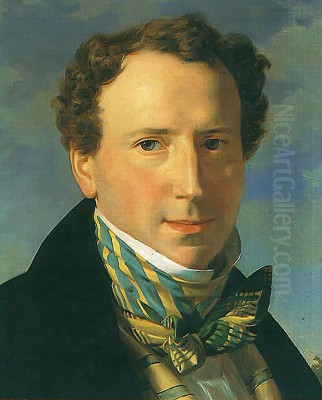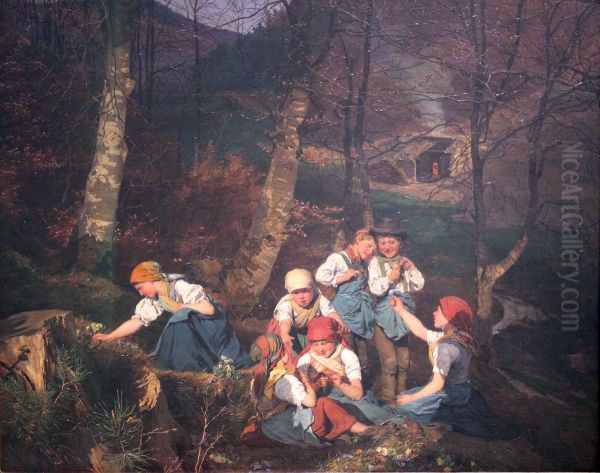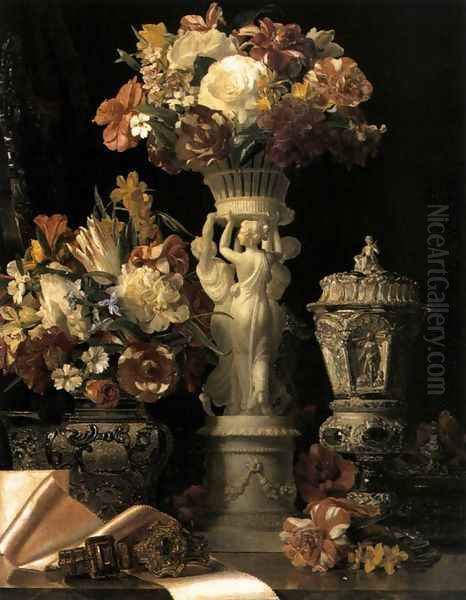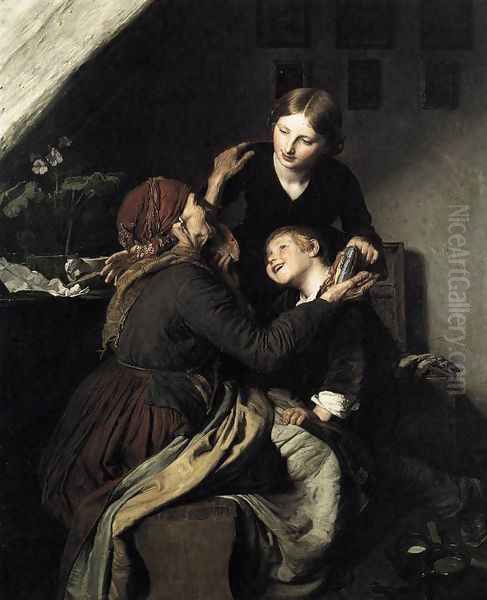
Ferdinand Georg Waldmüller stands as one of the most significant Austrian painters of the 19th century. Born in Vienna on January 15, 1793, and passing away near the city in Hinterbrühl on August 23, 1865, his life and career spanned a period of profound social and artistic change. He is particularly renowned as a leading figure of the Biedermeier era, a period characterized by a focus on domesticity, realism, and the burgeoning middle class in Central Europe. Waldmüller's diverse oeuvre encompasses landscape, portraiture, still life, and genre painting, all marked by an extraordinary commitment to naturalistic observation and technical brilliance.
Waldmüller's influence extended beyond his canvases; he was also a vocal advocate for artistic reform, challenging the established academic practices of his time. Though this led to conflict, his dedication to truthfulness in representation and his pioneering use of light left an indelible mark on Austrian art, paving the way for later realist and impressionist movements. His works remain highly prized, celebrated for their meticulous detail, luminous quality, and insightful depiction of the world around him.
Early Life and Artistic Formation
Ferdinand Georg Waldmüller's journey began in Vienna, the vibrant heart of the Habsburg Empire. Born into modest circumstances, his early life was marked by financial constraints. Despite these challenges, his innate artistic talent was evident from a young age. This promise secured him entry into the prestigious Vienna Academy of Fine Arts, though his attendance was intermittent, possibly due to the need to support himself.
During these formative years, Waldmüller honed his skills through various means. He undertook studies at the Academy under professors like Hubert Maurer and Johann Baptist Lampi the Elder, absorbing the prevailing Neoclassical and late Baroque traditions. However, financial necessity compelled him to seek practical work. He found employment creating miniatures and portraits, skills that demanded precision and close observation – qualities that would become hallmarks of his mature style. He also worked for a time as an art teacher for the children of Count Gyulay in Croatia, broadening his experiences beyond Vienna.

These early experiences, balancing formal study with the practical demands of earning a living through art, shaped Waldmüller's pragmatic approach. He developed a strong work ethic and an intimate understanding of different artistic formats. His time spent capturing likenesses in portraits likely sharpened his eye for detail and individual character, laying the groundwork for his later achievements in portraiture and genre painting.
The Biedermeier Context
To fully appreciate Waldmüller's art, it is essential to understand the Biedermeier period in which he flourished. Roughly spanning the years between the Congress of Vienna (1815) and the Revolutions of 1848, this era in German-speaking Europe was characterized by a retreat into the private sphere. Following the upheavals of the Napoleonic Wars, political censorship and surveillance encouraged a focus on home, family, and the perceived simplicities of everyday life.
Artistically, the Biedermeier style reflected this inward turn. It moved away from the grand historical narratives of Neoclassicism and the dramatic emotionalism of High Romanticism, as exemplified by artists like Jacques-Louis David in France or Caspar David Friedrich in Germany. Instead, Biedermeier art favoured realism, intimacy, and meticulous detail. Genre scenes depicting domestic harmony, portraits capturing individual likeness without excessive idealization, detailed landscapes, and precisely rendered still lifes became popular subjects.
Waldmüller emerged as a quintessential Biedermeier painter. His work perfectly captured the era's ethos, celebrating the beauty found in the ordinary. His detailed depictions of nature, his sensitive portraits of middle-class citizens and nobility alike, and his charming genre scenes resonated with the tastes of the time. He elevated the everyday through careful observation and masterful technique, finding significance in the textures of fabric, the play of light on fruit, or the subtle expressions on a sitter's face.
Artistic Style and Philosophy: A Commitment to Nature
Waldmüller's artistic philosophy was rooted in an unwavering commitment to the direct study of nature. He became a fervent advocate for Naturalism and Realism, believing that art should accurately reflect the visible world. This put him at odds with the prevailing academic methods taught at the Vienna Academy, which emphasized copying classical sculptures and the works of Old Masters as the primary means of instruction. Waldmüller argued passionately that artists should learn directly from the source – nature itself.

A cornerstone of his practice and teaching was plein air painting – the act of painting outdoors to capture the fleeting effects of light and atmosphere accurately. While later associated strongly with the French Impressionists like Claude Monet and Camille Pissarro, Waldmüller was an early proponent of this approach in Austria. He believed that only by observing sunlight directly could an artist truly understand and depict its nuances, its warmth, and its effect on colour and form.
His paintings are characterized by their remarkable clarity, meticulous detail, and luminous quality. He paid extraordinary attention to texture, rendering fabrics, foliage, skin, and objects with almost photographic precision. Light is arguably the central subject in many of his works; he masterfully captured the bright, often harsh, Austrian sunlight, using it to define form, create contrast, and imbue his scenes with vitality. His style shows an affinity with the detailed realism of Dutch Golden Age painters, perhaps recalling the precision of still-life artists like Jan van Huysum, while his dramatic use of light might occasionally echo the chiaroscuro of Caravaggio, albeit adapted to a Biedermeier sensibility.
Masterpieces and Major Themes: Landscapes
Landscape painting formed a significant part of Waldmüller's output. He approached the Austrian countryside with the same dedication to realism that marked his other work. Rejecting idealized or romanticized views, he sought to capture specific locations at particular times of day, under distinct weather conditions. His landscapes are notable for their bright, clear light and astonishing level of detail, from individual leaves on trees to the textures of rocks and earth.
A prime example is Brushwood Collectors in the Vienna Woods (1855). This painting depicts peasants gathering wood, a common rural activity, set within a meticulously rendered forest scene. The sunlight filtering through the dense canopy is captured with brilliance, illuminating the figures and the forest floor. The work combines landscape and genre elements, showcasing both his skill in rendering nature and his interest in the lives of ordinary people.
Other landscapes, like views of the Prater park in Vienna or the Salzkammergut region, similarly demonstrate his commitment to plein air observation. He captured the specific character of the Austrian landscape, its lush greenery, rolling hills, and the sharp clarity of its alpine light. While lacking the atmospheric dissolution of later Impressionism, Waldmüller's landscapes were revolutionary in their time for their directness and fidelity to visual experience, influencing subsequent generations of Austrian landscape painters like Emil Jakob Schindler and the artists associated with the Plankenberg colony.
Masterpieces and Major Themes: Genre Scenes

Waldmüller excelled in genre painting, depicting scenes of everyday life with sensitivity, detail, and often a gentle narrative or emotional core. These works perfectly encapsulate the Biedermeier focus on the domestic and the commonplace, yet Waldmüller often imbued them with subtle social commentary or keen psychological observation. He frequently depicted peasant families, children, and moments of quiet domesticity.
Conscript's Farewell (1854) is one of his most powerful genre scenes. It portrays the emotional moment a young man leaves his family to join the army. The varied reactions of the family members – the stoic father, the weeping mother and sister, the oblivious younger child – are captured with poignant realism. The painting reflects the social realities of the time, including mandatory military service, and explores universal themes of family bonds and separation.
Other notable genre works include Mother's Joy (Mutterglück), which humorously and tenderly depicts the simple pleasures of family life, a recurring and successful theme for the artist. Meeting in the Woods offers another glimpse into rural life, while The Intercepted Love Letter (Belauschte Liebesleute) showcases his ability to capture narrative tension and subtle human interactions within a detailed setting. These works stand in contrast to the more overtly moralizing or sentimental genre scenes of earlier artists like Jean-Baptiste Greuze, offering instead a more direct, observed portrayal of life. His focus on the lives of peasants and children also carried a layer of social awareness, sometimes highlighting hardship and poverty beneath the Biedermeier surface.
Masterpieces and Major Themes: Portraits
Portraiture was a constant throughout Waldmüller's career, from his early days earning a living to his later years as an established master. He brought the same commitment to realism and detailed observation to his portraits as he did to his landscapes and genre scenes. He sought not just a physical likeness but also a sense of the sitter's personality and social standing, captured through pose, expression, and the meticulous rendering of clothing and setting.
The Portrait of the Notary J. A. Elster (1835) exemplifies his skill in this genre. The notary is presented with a direct gaze, his features rendered with sharp clarity. The textures of his clothing and the papers on his desk are depicted with painstaking detail, conveying his professional status and the Biedermeier appreciation for material reality. Waldmüller avoided excessive flattery, presenting his sitters with an honest, often unvarnished, realism.
Waldmüller painted numerous prominent figures, including members of the Viennese bourgeoisie and aristocracy. He famously created a portrait of the composer Ludwig van Beethoven, likely based on existing images or possibly a life mask, which has become one of the iconic representations of the composer. He also received commissions from the imperial court, painting Emperor Franz I of Austria. His approach marked a shift from the more idealized or heroic portraiture styles seen earlier, aligning with the Biedermeier preference for verisimilitude and individual character, offering a different sensibility compared to, for instance, the society portraits of his English contemporary Sir Thomas Lawrence. Other key Viennese portraitists of the era, like Friedrich von Amerling, offered a slightly more elegant or romanticized counterpoint to Waldmüller's often starker realism.
Masterpieces and Major Themes: Still Lifes
Waldmüller's still life paintings are tours de force of observational skill and technical mastery. He approached arrangements of flowers, fruit, and objects with the same intensity and dedication to realism that characterized his other work. These compositions are often bathed in his signature bright, clear light, highlighting the textures, colours, and forms of each element with astonishing precision.
Still Life with Fruit, Flowers, and Silver Goblet is considered a masterpiece of the genre and a prime example of his realistic style. Every detail, from the dewdrops on a grape to the reflective surface of the silver goblet and the delicate petals of the flowers, is rendered with incredible fidelity. The composition is carefully arranged, yet the overall effect is one of vibrant naturalism. He captured the transient beauty of flowers and the ripeness of fruit, freezing a moment of abundance in time.
These still lifes demonstrate Waldmüller's profound understanding of light and texture. They showcase his ability to differentiate between the soft skin of a peach, the smooth hardness of porcelain, the intricate weave of a tablecloth, and the cool sheen of metal. While rooted in the tradition of Dutch and Flemish still life painting, Waldmüller's works possess a distinct clarity and luminosity characteristic of his unique style and the Biedermeier aesthetic. They stand as testaments to his belief in the artistic significance of close observation of the tangible world.
Advocacy and Academic Conflict
Beyond his prolific output as a painter, Waldmüller was a passionate and often controversial advocate for reform in art education. Having spent time as a custodian and later a professor at the Vienna Academy of Fine Arts, he developed strong opinions about its teaching methods, which he came to see as outdated and detrimental to genuine artistic development. He published several polemical treatises outlining his ideas, most notably criticizing the emphasis on copying Old Masters and antique casts.
Waldmüller argued forcefully that the foundation of all art education should be the meticulous study of nature. He championed plein air painting and drawing directly from life models, believing that only through direct observation could students truly learn about form, light, and colour. He advocated for a curriculum that prioritized empirical study over the rote imitation of established styles. His views were radical for the time and placed him in direct opposition to the conservative academic establishment in Vienna.
His outspoken criticism and reformist zeal led to significant friction with his colleagues and the Academy's administration. Figures representing more traditional academic or Nazarene ideals, prevalent in German-speaking lands (like Peter von Cornelius or Joseph von Führich, though direct documented clashes might be with Viennese figures), would have found his approach fundamentally challenging. The conflict escalated, and despite his artistic reputation, Waldmüller was eventually forced into retirement from his teaching position in 1857. This episode highlights his principled, if perhaps undiplomatic, commitment to his artistic beliefs.
Later Years and Recognition
The forced retirement from the Academy in 1857 marked a difficult period for Waldmüller, potentially involving financial strain. However, he continued to paint with undiminished vigour and dedication. His reputation, though perhaps tarnished within the Academy walls, remained strong among collectors and the public, both in Austria and internationally. He continued to exhibit his work and receive commissions.
Gradually, the tide began to turn back in his favour. By the early 1860s, his contributions to Austrian art were being re-evaluated, and he began to be reintegrated into the official Viennese art scene. The rigid academicism he had fought against was slowly giving way to newer trends, some of which were influenced by his own pioneering work in realism and landscape painting.
In 1863, his status was significantly restored, and in 1865, shortly before his death, he received a significant honour: Emperor Franz Joseph I awarded him the Knight's Cross of the Order of Franz Joseph. This marked a belated official recognition of his artistic achievements. During his later life, he was married to his second wife, Anna Bayer, who reportedly ran a successful fashion salon in Vienna, suggesting a degree of social standing despite his academic controversies. Waldmüller died in August 1865 in Hinterbrühl, near Vienna, leaving behind a rich and influential body of work.
Connections and Contemporaries
Waldmüller did not work in isolation. His career intersected with numerous other artists, both in Vienna and beyond. While his relationship with the Academy was fraught, he maintained connections within the broader artistic community. His advocacy for naturalism resonated with younger artists who sought alternatives to academic dogma.
He was a central figure in the Biedermeier movement in Vienna, alongside contemporaries like the portraitist Friedrich von Amerling, the genre painter Peter Fendi, and Josef Danhauser, known for his historical and genre scenes. While their styles differed, they collectively defined the artistic character of the era in Vienna. The detailed cityscapes and landscapes of Rudolf von Alt also represent another facet of Viennese realism during this period.
Waldmüller's emphasis on plein air study and realistic landscape depiction had a profound impact on the next generation. Although the specific "Plankenberg colony" associated with Emil Jakob Schindler emerged later, Schindler and his circle, including artists like Marie Egner, Olga Wisinger-Florian, Tina Blau, and the future Secessionist Carl Moll, built upon the foundations laid by Waldmüller. Theodor von Hörmann was another landscape painter who shared this commitment to natural observation. Snippets also mention connections with painters named Ribarz (likely Rudolf Ribarz) and Jettel (likely Eugen Jettel), further indicating his network within the landscape painting community. His influence, therefore, extended through both direct interaction and the power of his example.
Legacy and Influence
Ferdinand Georg Waldmüller's legacy is multifaceted. He is remembered primarily as the preeminent painter of the Austrian Biedermeier period, capturing its spirit with unparalleled skill and insight. His mastery of light, meticulous detail, and realistic representation set a high standard for painting in 19th-century Austria. His works across all genres – landscape, portrait, still life, and genre scenes – remain benchmarks of the era.
His influence extended significantly beyond his own time. As a pioneer of plein air painting and a staunch advocate for the study of nature, he helped shift the course of Austrian art away from rigid academicism towards greater realism. He laid crucial groundwork for the development of Austrian landscape painting in the later 19th century, particularly the atmospheric realism or Stimmungsimpressionismus (Mood Impressionism) associated with Schindler and his followers.
Despite the controversies surrounding his teaching methods, his core ideas about the importance of direct observation eventually gained wider acceptance. Today, Waldmüller is celebrated not only for the technical brilliance and aesthetic appeal of his paintings but also for his role as a forward-thinking artist and reformer. His works are prominently displayed in major museums, particularly the Belvedere Museum in Vienna, and continue to be studied and admired for their enduring quality and historical significance.
Conclusion
Ferdinand Georg Waldmüller remains a towering figure in Austrian art history. As a master of the Biedermeier style, he captured the essence of his time with extraordinary technical skill and observational acuity. His luminous landscapes, insightful portraits, meticulously detailed still lifes, and engaging genre scenes offer a rich window into 19th-century Austrian life and aesthetics.
More than just a chronicler of his era, Waldmüller was a visionary artist who championed realism and the direct study of nature long before these ideas became mainstream. His advocacy for plein air painting and his critiques of academic dogma, though controversial in his lifetime, proved influential for subsequent generations. His unwavering commitment to depicting the world with honesty and precision, particularly his revolutionary handling of light, secured his place as a key innovator in European art. Waldmüller's legacy endures in his beautiful canvases and in his contribution to the evolution of modern painting.